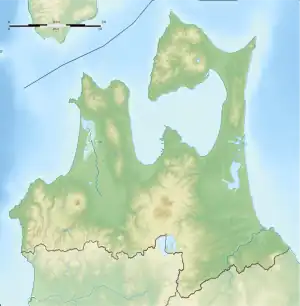Takayashikidate Site
The Takayashikidate ruins (高屋敷館遺跡, Takayashikidate iseki) is an archaeological site containing the ruins of a fortified settlement dating to the Heian period in what is now part of the city of Aomori, Aomori Prefecture, in the Tōhoku region of northern Japan. The ruins were designated a National Historic Site in 2012 by the Japanese government.[1]
高屋敷館遺跡 | |
 Shown within Aomori Prefecture  Takayashikidate Site (Japan) | |
| Location | Aomori, Aomori, Japan |
|---|---|
| Region | Tōhoku region |
| Coordinates | 40°44′13″N 140°35′04″E |
| Type | settlement |
| History | |
| Founded | 900 - 1100 AD |
| Periods | Heian period |
| Site notes | |
| Discovered | 1994 |
| Excavation dates | 2004-2005 |
| Public access | Yes (no public facilities) |
Overview
During the middle Heian period, the very far northern portion of Mutsu province was only tenuously within the control of the central government and was largely in the hands of Emishi tribes. In the latter half of the 11th century, the region experienced several major conflicts, including the Zenkunen War and Gosannen War.
Takayashikidate site has a protected area of approximately 30,000 square meters (500 meters north-south by 90 meters east-west), in the center of which are the ruins of a fortified village inhabited from the 10th century through the 12th century AD, or the middle to end of the Heian period. The settlement was surrounded by a moat, which ranged from six to eight meters in width and up to four meters deep, with an earthen rampart and wooden palisade. The moat and rampart were penetrated by a gate which had many pillars, and the settlement itself contained at least 86 buildings, some of which were pit dwellings and some of which were stilt-pillar buildings connected by passageways. The settlement itself measured approximately 110 meters north-south by 80 meters east-west. The location of the site is on a fluvial terrace on the west bank of the Daishaka River at an altitude of 35-45 meters.
The site was discovered in 1994, during construction of the Namioka Bypass on Japan National Route 7. Partial excavation work was undertaken from 2004 to 2005 by the Aomori Board of Education, and approximately half of the settlement area was excavated. As a result of the excavation, the route of the bypass was shifted to the west to preserve the site.
A large number of artifacts were discovered, including fragments of cloth, housing materials, Sue pottery, lacquerware, agriculture tools, smithing tools and accessories and weapons. Due to the large amount of iron slag discovered, it appears that the settlement was a center for blacksmithing or metal working
The settlement was abandoned for unknown reasons, and the moat became filled in. The area was subsequently used as an orchard. The site is approximately five minutes by car from the JR East Namioka Station.
References
- "高屋敷館遺跡" [Takayashikidate Site] (in Japanese). Agency for Cultural Affairs. Retrieved 12 June 2012.
External links
- Aomori City official site (in Japanese)
- Aomori City official site (in Japanese)